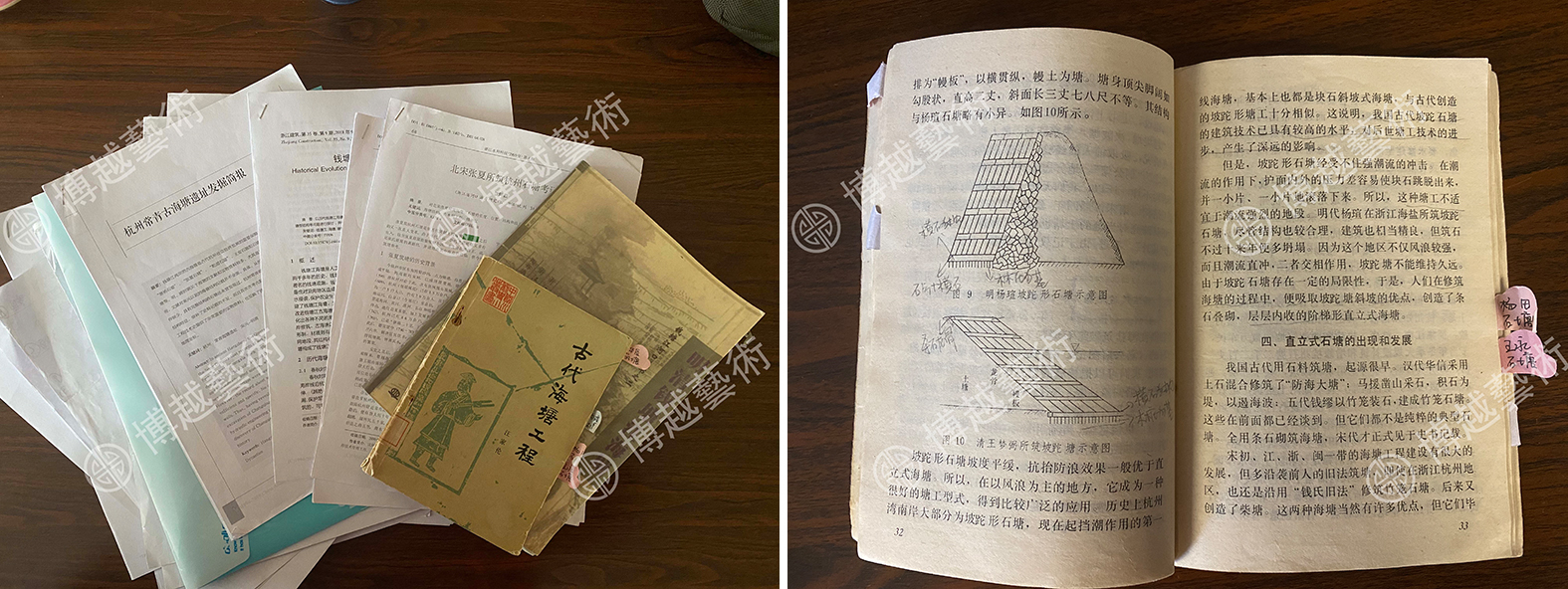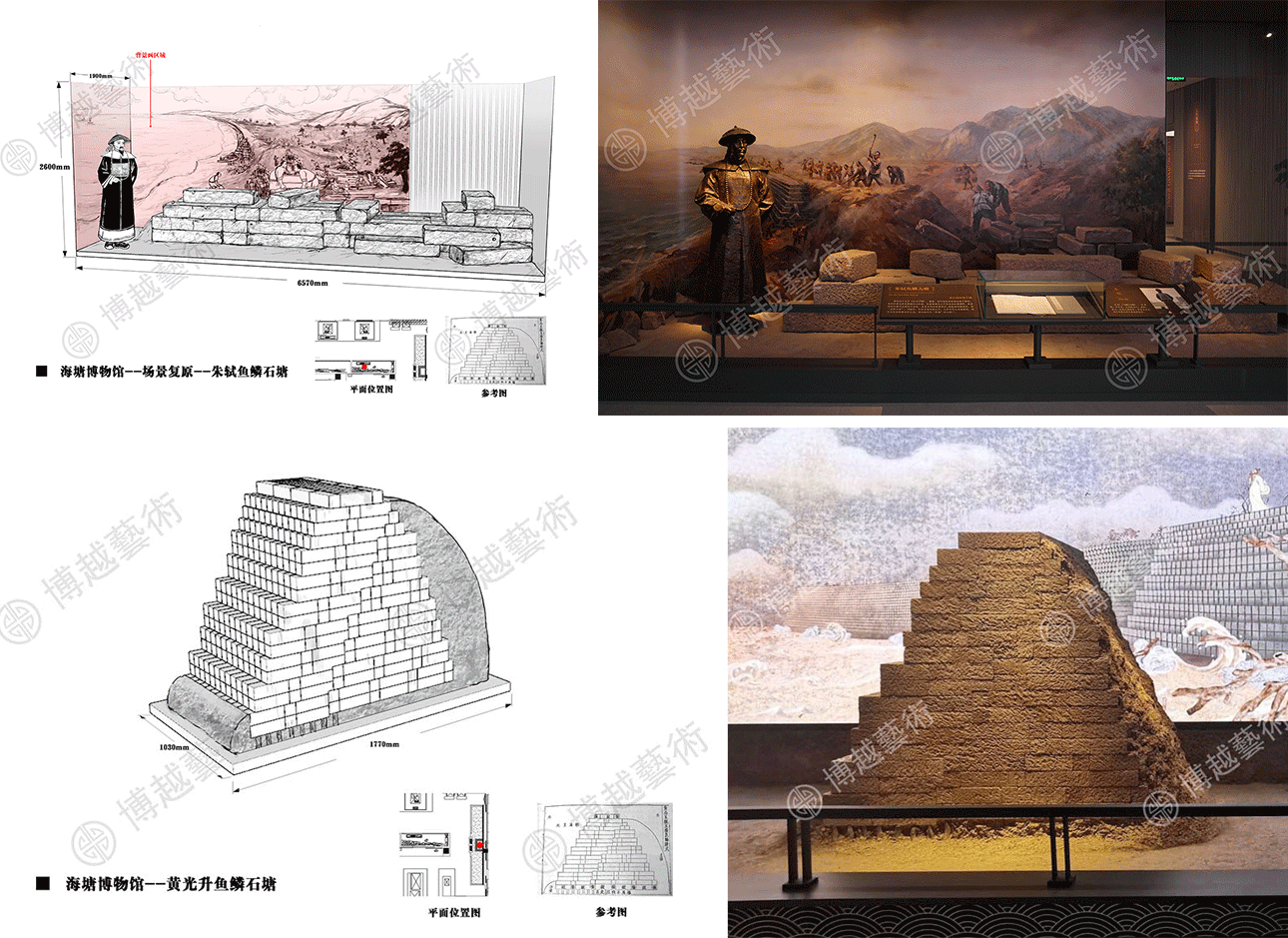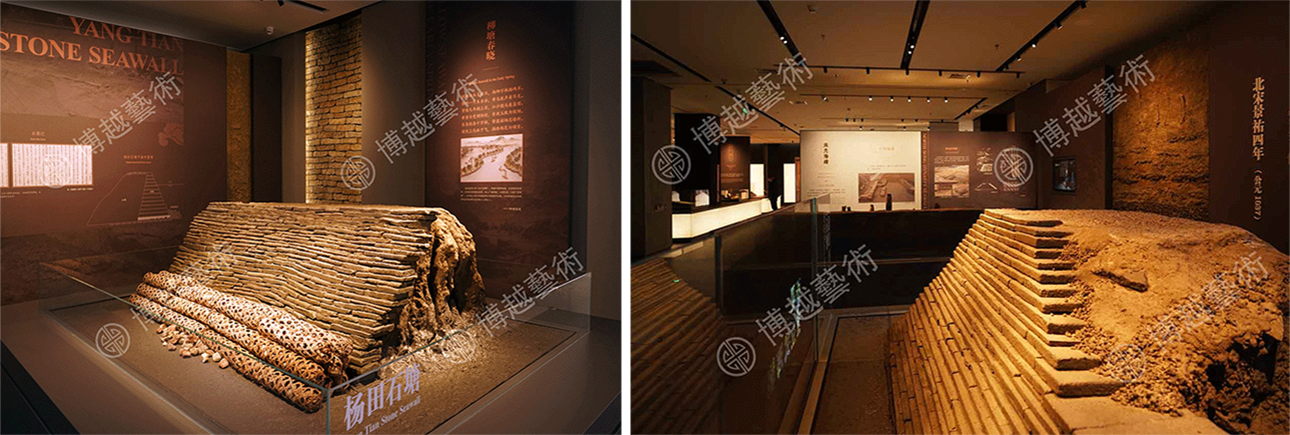The scene art of the museum is a complex and diversified exhibition space creatively reconstructed, integrating specific factors including time, place, people and events, which is based on history and culture. It focuses on presenting the social landscape and humanistic life of a certain time and place, and enhances the sense of space, authenticity and cultural identity of the exhibition by creating rich sensory experience.
It is full of the wisdom and sweat of craftsmen behind those lifelike scenes. Each working procedure of the exquisite carving and each process of the excelsior, in terms of research, planning, design, production and the like, reflect their persistence and perseverance, making craftsmanship by hearts, and achieving brilliant achievement by craftsmanship.
Exploring the Truth of History Word by Word
In 2019, a series of themed scenes and exhibits were made for Museum of Seawall Site of Hangzhou by Shanghai Boyue Art Institution Co.,Ltd. With the exquisite scene and model display, the ancient seawall along Qiantang River of Hangzhou area gradually fades its surface dust and sand, revealing its own magnificent splendor.

Historical research is the basis of scene creation, whose details and reality determine the vitality of the scene. For studying the history of the ancient seawall, the planner shuttled between the libraries and the book markets to collect relevant information within his capacity due to the lack of authoritative information and opinions as far as possible. As for the questions or errors in historical documents, the planner screened them one by one with rigorous methods, and deduced reasonable historical conclusions through sorting, comparison and analysis. Taking Yulinshitang from Zhu Shi as an example, General Records of Seawall of Zhejiang Province in the period of QianLong Dynasty recorded its structure and construction method with pictures and texts, which was subtly different from the structure recorded in the Ancient Seawall Project(1988). The historical truth can be discovered only by comprehensively collecting and comparing data of the same type. The process of research has always been tortuous, can not be accomplished overnight, can not do it once and for all. The planner chased every detail and dug into every data, weaving the the overall awareness of seawall of Hangzhou via "word by word", which has laid the academic foundation for the later scene production.

With the deepening of the research, difficulties emerge one after another. How to understand the rarely-used Chinese characters? How to convert the unit size of different ages? What was the structure of the ancient seawall? What was about its structure? These questions still need the planners to continue to think, discuss, and make further research. They may try to contact authoritative experts, humbly consult, or carry on the visualization processing to the text, or check the missing to fill the vacancy. For the part they were researching without data to check, the planner adjusted the research idea after discussion, presented it as a "story-telling", and explored the cultural connotation behind it. Boring research tests the planners' patience, whose hardships behind are their passion for history and persistence in research. Persistence will eventually uncover the veil of history.
Stroking the Outline of the Times with One Stroke at A Time
The data research is gradually approaching the end, designers take over the baton of scene creation from the hands of the planners. Unlike other art creations, they will solve a huge problem, that is, how to turn boring cultural knowledge into visual content with aesthetic value. The designers of Boyue have accumulated a great of experience in many previous projects, and have a comprehensive understanding of the basic features of ancient buildings in different times and regions, which makes them well-placed to win. Beyond that, they also carefully studied the relevant materials according to the specific content of the scene, and mastered its characteristics of the times, geographical environment, architectural characteristics, seasonal climate and other details given. For example, the model design of the ancient seawall, based of the scene design combining with the overall spatial layout of the museum, adjusts and guides the visitors' visual focus from a macro perspective, and fully demonstrates the grand momentum of the ancient seawall through a large number of details supported.

Among others, design requirements are not the same for different themes of the scene. For instance, in the scene of " Huaxin built pond", the designer needs to accurately depict the details such as the characters from primary to secondary, body movements, facial expressions, clothing, etc. Like photography, the dynamic scene will be accurately captured and frozen to reproduce. When designing the historical scene of " Sunken stones in bamboo cages ", they will carefully choose the structural frame, space extension, echos in light and dark, and order of the picture. The visual points are grouped into lines and planes to create a strong visual impact, thus, to deepen the image perception. And meanwhile, the designer also put the stylized creation into the scene design, skillfully applying the techniques of traditional Chinese art expression, which highlights the unique charm of traditional art and enhances the cultural atmosphere of the pavilion.

Scene design is a concrete construction of historical stories and human life. To design a theme scene that touches the viewers, the designer should take into account both historical authenticity and artistic expression.On the base of different topics and perspectives, exploring the historical value and aesthetic charm of the scene to make it real and vivid, so as to achieve a benign interaction between the scene and the audience and stimulate their aesthetic feelings.

Casting Brilliant by Ingenuity with Brick by Brick
If the design gives the scene life, then the craftsman would give the scene soul. The ancients built the "Great Wall on Water" on the river and sea with their superb wisdom and technology. Today's artisans condense the skills and wisdom of ancient artisans in a new place with the scene art. For achieving it complete, they conduct a number of exquisite processes step by step, in terms of drawings reading, proportion calculations, sample making, stack mounting, material selection, cutting, shaping, adjusting, coloring, etc.

As objects have their soul, the craftsmen are naturally humble. Today's artisans follow the path of our predecessors, obsessing over a single field, striving for perfection in their boring craftsmanship, which make them burst out in silence and sublimate in the ordinary. Each inheritance is the recognition of the ability to the successor, the result that traditional craft was carried forward, but also the spirit of the craftsmen continuing from generation to generation.

The seawall was eroded by the sea water, the black bricks were engraved with marks by time, in which every step that is exquisite, dedicated, and devout, is the practice of artisans with a thousand twists and turns. The artisans, with their fingers full of spirit, have worked out exquisite craft, pursued the sincere dream, inherited the skills, as well as explored the throb and brightness of the soul.
Inspiring the Resonance of the Times by Heart and Soul
With the development of the times, scene art has made a great breakthrough in both the production concept and the expression technique. Traditional exhibition is gradually unable to meet the diversified needs of the public. The organic combination with multimedia makes up for this vacancy and enhances the experience and immersion of the exhibition. With the rapid development of immersive exhibitions in the fields of culture, art and even business, questions have come up. Will digital technology replace traditional technology? What impact will the rapid development of science and technology bring to the museology art scene? Behind the popularity of "dazzling technology", can the public be satisfied with their inner world? This will be an important proposition in the new exhibition era.
Boyue, who has been working in the field of literature and museology for decades, believes that only through continuous innovation and thinking, they can create better works. Digital technology and traditional craft are two sides of mutual interpretation. Science and technology, as a kind of mean, provides new possibilities for exhibitions, while the traditional craftsmanship touches on the intrinsic value of exhibitions. The two will help and grow with each other in the process of mutual contradiction and mutual promotion. Therefore, artists should integrate science and technology with tradition, and through the expression of different themes and forms, evoke the profound humanistic induction and aesthetic resonance, thus colliding with each other to create artistic sparks across the ages.
Reference
Application Research of “Scene Reconstruction“in Temporary Exhibition of Museum,Feng Suo.
Art Design in the Teaching of Typical Art Scenes in Museum -- A Case Study of Vocational Education Museum, Liu Jiao.
The Museum Exhibition Space Scene Creation, Peng Wenqing.
Study on the Method of Scene Presentation,Yu Fanli.
Shanghai Boyue Art Institution Co.,Ltd.
